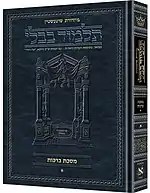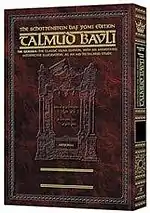| Part of a series of articles on |
| Editions of the Babylonian Talmud |
|---|
 |



The Schottenstein Edition of the Babylonian Talmud is a 20th-century, 73-volume edition of the Babylonian Talmud (Talmud Bavli) featuring an elucidated translation and commentary, and published by ArtScroll, a division of Mesorah Publications.
It is the first Orthodox non-academic English translation of the Babylonian Talmud since the Soncino Edition. It has gained much popularity since its release and is used in many congregations throughout the English-speaking world;[1] it is now published in three languages: English, French, and Modern Hebrew.[2]
Rabbis Chaim Malinowitz and Yisroel Simchah Schorr are the general editors of the project.[3] Nothing was considered final until Malinowitz approved the finished drafts.[4]
History
The first volume, Tractate Makkos, was published in 1990, and dedicated by Mr. and Mrs. Marcos Katz. Subsequent editions were produced with the financial assistance of Jerome Schottenstein, an Orthodox Jew and founder of an Ohio department store.[5] The total cost of the project was $40,000,000 (including the Hebrew edition); some sources estimate the cost of production for each volume to be $250,000.[6] The publication of all 73 volumes took fifteen years.[7]
Structure
Each page of the Hebrew/Aramaic text is in the classic Vilna style, with various classical commentaries (such as Rashi) surrounding the text of the Mishnah and Gemara. Each Hebrew page is opposite a page of English translation—one Hebrew folio takes approximately six to eight pages of English to translate.[2] The literal meaning of the text is shown in bold, while supplementary words and phrases that ease the quick transition of topics are shown in regular font.
The English-language commentary is primarily based on Rashi's, and describes his continuing importance as follows:
It has been our policy throughout the Schottenstein Edition of the Talmud to give Rashi's interpretation as the primary explanation of the Gemara. Since it is not possible in a work of this nature to do justice to all of the Rishonim, we have chosen to follow the commentary most learned by people, and the one studied first by virtually all Torah scholars. In this we have followed the ways of our teachers and the Torah masters of the last nine hundred years, who have assigned a pride of place to Rashi's commentary and made it a point of departure for all other commentaries.[8]
The editors explained further that they chose Ran's commentary for Tractate Nedarim as an exception, based on a belief that the commentary attributed to Rashi for this tractate was not written by Rashi.
See also
References
- ↑ Eichler.com review of the Edition, the exact page can be found at http://www.eichlers.com/Product/Books/Talmud_and_Mishnah/Artscroll_Schottenstein_English_Talmud_Bavli/Artscroll-Schottenstein-Edition-of-the-Talmud---Daf-Yomi-Edition-_004-1.html#FullDescription
- 1 2 "ArtScroll.com - The Schottenstein Edition Talmud Bavli — in Hebrew as well as English". www.artscroll.com.
- ↑ "BD'E – Harav Chaim Zev Malinowitz, Zt"l". Hamodia. 21 November 2019. Retrieved 16 December 2019.
- ↑ Scherman, Nosson (27 November 2019). "Concealed Greatness". Mishpacha. Retrieved 16 December 2019.
- ↑ Berger, Joseph. (10 February 2005) An English Talmud for Daily Readers and Debaters The New York Times.
- ↑ Eichler.com review of the Edition
- ↑ Scherman, Nosson; Kasnett, Nesanel (2005), "The Schottenstein Edition of the Babylonian Talmud: The next stage in Talmudic elucidation", in Mintz, Sharon Liberman; Goldstein, Gabriel M. (eds.), Printing the Talmud: From Bomberg to Schottenstein, Yeshiva University Museum, p. 156, ISBN 9780945447160
- ↑ The Schottenstein Edition of the Talmud: Talmud Bavli: Tractate Nedarim. Mesorah Publications Limited, 2000 (General Introduction, unpaginated).